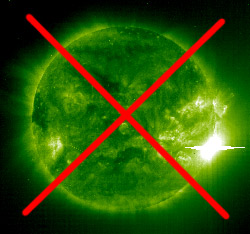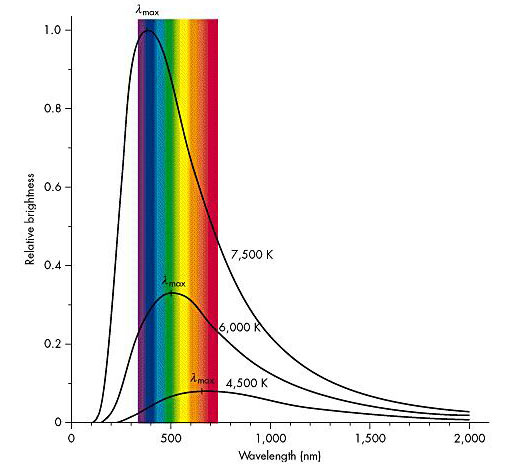Why green stars do not happen?

Go out on a dark, moonless night. Look up. If it is December or January, pay attention to Betelgeuse, who is burning with a red light on Orion's shoulder, and Riegel, a bright blue star at his knee. In a month, a yellow choir will appear in the constellation of the charioteer.
If it's July, look for Vega, Lyra sapphire blue, or Antares, Scorpio’s orange-red heart.
')
There are no green stars! At any time of the year in the sky you can find different stars. Most look white, but the brightest shows color. Red, orange, yellow, blue - almost all the colors of the rainbow ... But, wait a minute, but where are the green ones? Shouldn't we see those too?
Not. This is a very frequent question, and we see no green stars. And that's why.
Take a blowtorch (mentally) and heat the iron bar. At first it will glow red, then orange, then white and blue. Then it will melt. It is better to use tack.
Why is it glowing? Any matter of temperature above absolute zero (about -273 ° C) emits light. The amount of light and the length of its wave depends on the temperature. The warmer the object, the shorter the wavelength.
Cold objects emit radio waves. Very hot emit ultraviolet or x-rays. In a very narrow temperature range, hot objects will emit visible light, roughly wavelengths from 300 nm to 700 nm.
It should be noted that objects do not emit light at the same wavelength. They emit photons in the wavelength range. If you used some kind of detector sensitive to the wavelengths of the light emitted by the object, and then plotted the number of these waves on the graph, you would get a curved graph called the “black body emission characteristic” (why it is so called, it doesn't matter, but if Interesting, you can search. Just turn on the search results filter. Seriously). It is a bit like the bell of the normal distribution curve, but at small wavelengths it falls faster, and at longer wavelengths it falls more slowly.
Here are examples of several curves for different temperatures:

The wavelength (or color, if you wish) is plotted along the x axis, and a spectrum of visible colors is superimposed on the graph for reference. It may be noted characteristic bell-shaped form. In hot objects, the peak is shifted to the left, to shorter waves.
At an object with a temperature of 4500 Kelvin (about 4200 ° C), the peak is in the orange part of the spectrum. Heat it to 6000 K (approximately the temperature of the Sun, 5700 ° C), and the peak moves to the green-blue region. Heat more, and the peak moves to the blue area, or even further, to shorter wavelengths. The hottest stars emit most of the light in the ultraviolet, at shorter wavelengths than those we see with the naked eye.
Hmm, wait a second. If the Sun has a peak in a green-blue area, why doesn't it look green-blue? This is the key question. The thing is that although the peak falls on the green-blue region, it also emits light and other colors.
Look at the graph of the object with a temperature close to the sun. The peak occurs in the green-blue region, so most of the photons are emitted there. But both blue and red photons are emitted. Looking at the sun, we see all these colors at once. Our eyes mix them and give one color - white. Yes, white. Some say that the Sun is yellow, but if it really was yellow, then the clouds and snow would also be yellow (all the snow is full, and not just the part you have in the yard where the dog is walking).
Therefore, the sun does not look green. But can we play with the temperature to get a green star? Perhaps one that is slightly warmer or colder than the Sun?
It turns out that we can not. A warmer star will give out more blue, and a cold one will give out more red, and in any case our eyes will not see green there. The blame for this must be laid not on the stars (not fully, at least), but on ourselves.
In our eyes, there are light-sensitive cells, cones and rods. Sticks are brightness sensors, they do not distinguish colors. Cones see colors, and there are three kinds of them: sensitive to red, blue, and green. When color falls on them, each is excited in different ways: the red color excites red cones, while the blue and green remain indifferent to it.
Most objects do not emit and do not reflect a single color, so cones are excited all at once, but to varying degrees. For example, an orange causes red cones to be twice as strong as green cones, and leaves blue alone. When the brain receives a signal from three cones, it says: “Probably, this is an orange object.” If the green cones see as much light as the red, and the blue can not see anything, we interpret the color as yellow. And so on.
Therefore, the only way for a star to look green is to emit only green light. But from the graph above it is clear that this is impossible. Any star emitting green will also emit quite a lot of red and blue, which will make it white. Changing the temperature of the star will turn it into orange, yellow, red or blue, but green will not work. Our eyes just won't see her like that.
Therefore, green stars do not exist. The colors emitted by the stars and the way our eyes interpret them guarantee this.
But it does not bother me. If you look through a telescope and see the shining Vega or the ruddy Antares, or the dark orange Arcturus, this will not worry you too much. The stars are not all colors, but they are enough, and because of this they are amazingly beautiful.
Source: https://habr.com/ru/post/400595/
All Articles